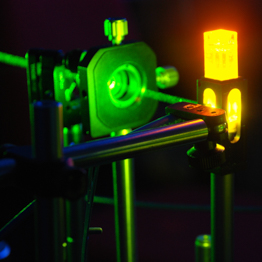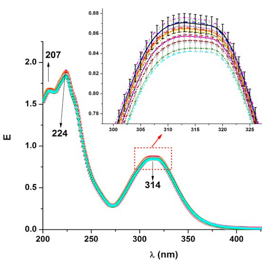Finished PhD
Studies on the behavior of fluids in the field of laser radiation
Best Doctoral Thesis Award, Exact Sciences and Engineering on 2018, received from the Senate of University of Bucharest
The original results presented in this thesis focus mainly on laser interactions with suspended liquid drops in open air. These studies are interdisciplinary covering several areas of fundamental and technological research, such as: microfluidics, spherical resonators, optofluidics, spontaneous emission amplification effects and / or stimulated emission in optical spectroscopy. The obtained results, thought belonging to fundamentals of physics, have potential applications in: detection in biological systems, tunable micro-lasers, biomedical applications, environment quality monitoring. During these studies, both the resonant and non-resonant interactions at the exposure of suspended droplets to laser pumping beams were monitored and evaluated. Resonant interactions occur when solution components (for example, molecules) of assay medium absorb incident radiation, usually the effects consisting in passing molecules from fundamental singlet state to an excited singlet state. The return of excited molecules to corresponding fundamental singlet states is accompanied by either fluorescence emission, or phosphorescence, or non-radioactive processes. Another possible effect is the dissociation of absorbing molecules and production of new substances derived from parent molecules. This is specific to laser photochemistry. Non-resonant interactions takes place when laser beam is not absorbed by the droplet constituents. Their effects are due to the pressure of light exerted on droplet, to electrostriction forces and to local and/or global thermal changes in the droplet.
Generation and testing the photoreaction products obtained from the exposure of solutions of drugs to laser beams
The discovery of compounds with direct antimicrobial effects obtained by laser irradiation of a drug is a further step in overcoming the gap created in antimicrobial research. Developing new antimicrobial agents by the repurposing of current non-antibiotics could have a major benefit in allowing the extended reuse of existing medicines. The modification of medicine’s molecular structures through laser radiation represents a new approach in chemistry, biology, and pharmacology. The generated photoproducts and their concentrations can be controlled through irradiation process, by choosing the proper laser wavelength, the time and the dose of irradiation. The original contributions of the doctoral thesis represent the combination of both spectroscopic and physico-chemical analytical methods and antimicrobial susceptibility assays to demonstrate that 266 nm irradiated chlorpromazine and thioridazine are suitable candidates in fighting antimicrobial resistance.
Optical and spectral study of medicine solutions stability in variable environment conditions
The stability of medicine solutions (already approved medicines or new designed compounds with antimicrobial potential) was characterized through optical and spectral techniques. From the end-user point of view, it is important to know for how long medicine can be stored without modifying its properties and what are the storage conditions for it to remain unmodified. The stability studies where performed in constant environment conditions (constant temperature, same illumination etc.) and variable environment conditions, considering factors like storage temperature, the solvent used for medicine solutions, illuminations conditions. Studying the stability of medicines solutions in different illumination conditions (photostability) represents an important part of the thesis, first of all, to establish the quantity/ dose of radiation (ambient light or laser radiation) to which medicine can be exposed without modifying its properties and secondly, to determine the illumination condition in which a known medicine can be modified with the purpose of generating photoproducts with enhanced antimicrobial activity compared with the original medicine. Thus, the theme of the PhD thesis contributes to the research efforts in combating multidrug-resistant bacteria through characterization of new compounds designed as antimicrobials and characterization of medicines solutions photostability and of photoproducts generated by exposing medicines solutions to laser radiation.
In progress
In progress...
The study of chaotic behavior of the laser systems emission
The purpose of the Thesis was to provide new data on the analysis of chaotic dynamics in the LFF regime induced in the semiconductor laser emission with external optical feedback, and its control and synchronization using external cavity semiconductor laser (ECSL) systems. The optical feedback was obtained by placing in the laser beam path an external optical reflector (a mirror or a diffraction grating), which delimits the external cavity, returning a part of the radiation at the diode junction level. The ECSLs are a particular class of chaotic nonlinear systems on which is focused the most efforts due to their unique properties (small size and easiness to use), and to the possibility of frequency modulations of the GHz order, with applications in high speed optical communications.
Studies were achieved to characterize the chaotic emission and its control by electrical and electro-optical modulation techniques, and the chaotic dynamic synchronization of two coupled lasers, applicable to encoded transfer of information. Issues related to objectives were approached by experimental and numerical studies. The chaotic dynamics was characterized with respect to parameters such as injection current, laser diode thermostatic temperature, optical feedback intensity, and the external cavity length. Different dynamic states were revealed by numerical simulations considering an electro-optical modulator in the external cavity. Among the observed dynamical states are found: low-frequency fluctuations of laser emission, laser and modulator phase locking, frequency modulation, and multimodal instability. These states depend of the applied frequency and modulation factor.
Optical properties study of the environmental pollutants
Pharmaceutically active compounds (PhAC) are an important group of emerging environmental contaminants that has been an issue of increasing interest in the international scientific community in recent years. Comparing with conventional priority pollutants (persistent organic pollutants, heavy metals, etc), PhAC are designed to have specific pharmacologic and physiologic effects at low doses and thus are inherently potent, often with unintended outcomes in wildlife.
The study of the optical properties of the compounds that constitute the pharmaceutical presentation of drugs is a very important link in environmental monitoring due to the current upward trend of the optical detection methods. Also, given the photo-degradation ability of these compounds, exposure of waste flows to optical radiation emitted by conventional and/or laser sources may be subject to systematically study. In this context, the photostability of the pharmaceutical products serves to study their behavior after exposure to optical radiation (natural or emitted by different optical sources).
This Thesis aims to undertake a study of optical properties of drugs selected from several therapeutic areas and how they behave at interaction with light, emitted by both the natural and artificial sources, particularly under the action of laser beams. The ultimate goal of this Thesis is to demonstrate that exposure of medicines solutions to different irradiation doses may constitute a mean of removing them from solutions either by their complete degradation or by inducing molecular structure changes in order to generate less toxic byproducts.






